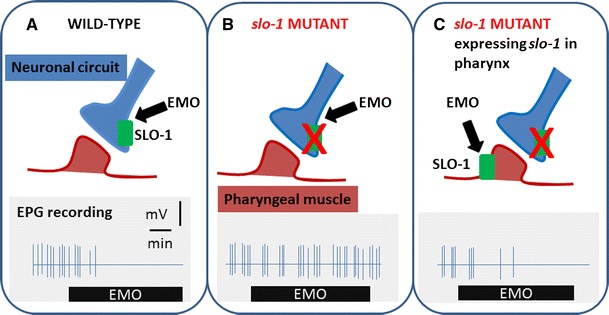Fig. 2.

Activation of SLO-1 by emodepside. A cartoon to illustrate data from Crisford et al. (2011) which showed that ectopic expression of slo-1 in C. elegans pharynx conferred sensitivity to emodepside in an otherwise emodepside resistant strain, slo-1 (js379), consistent with the proposal that emodepside interacts with the channel. a Wild-type C. elegans express slo-1 in pharyngeal neurones and not muscle (Chiang et al. 2006). Application of emodepside inhibits pharyngeal activity (recorded by an electropharyngeogram, EPG) by interfering with signalling in the pharyngeal circuit in a slo-1 dependent manner (Guest et al. 2007). b The slo-1 null mutant has an altered pattern of pharyngeal activity that consists of bursts of pumps occurring together, represented by the cartoon of the EPG. This reflects the role of slo-1 in patterning the activity in the neural circuit that drives feeding behaviour (Dillon et al. 2009). However, the slo-1 mutant is completely resistant to the inhibitory effects of emodepside, consistent with its pivotal in the mode of drug action (Dillon et al. 2009; Crisford et al. 2011). c Ectopic expression of slo-1 from the pharyngeal muscle-specific promoter myo-2 fails to rescue the disrupted pattern of pharyngeal activity (i.e. the bursting activity is still observed) in line with earlier observations that this is a neuronally derived phenotype; however, it does confer sensitivity of the pharynx to emodepside. This is consistent with the suggestion that emodepside can signal through SLO-1 when it is ectopically expressed in the muscle to inhibit activity
